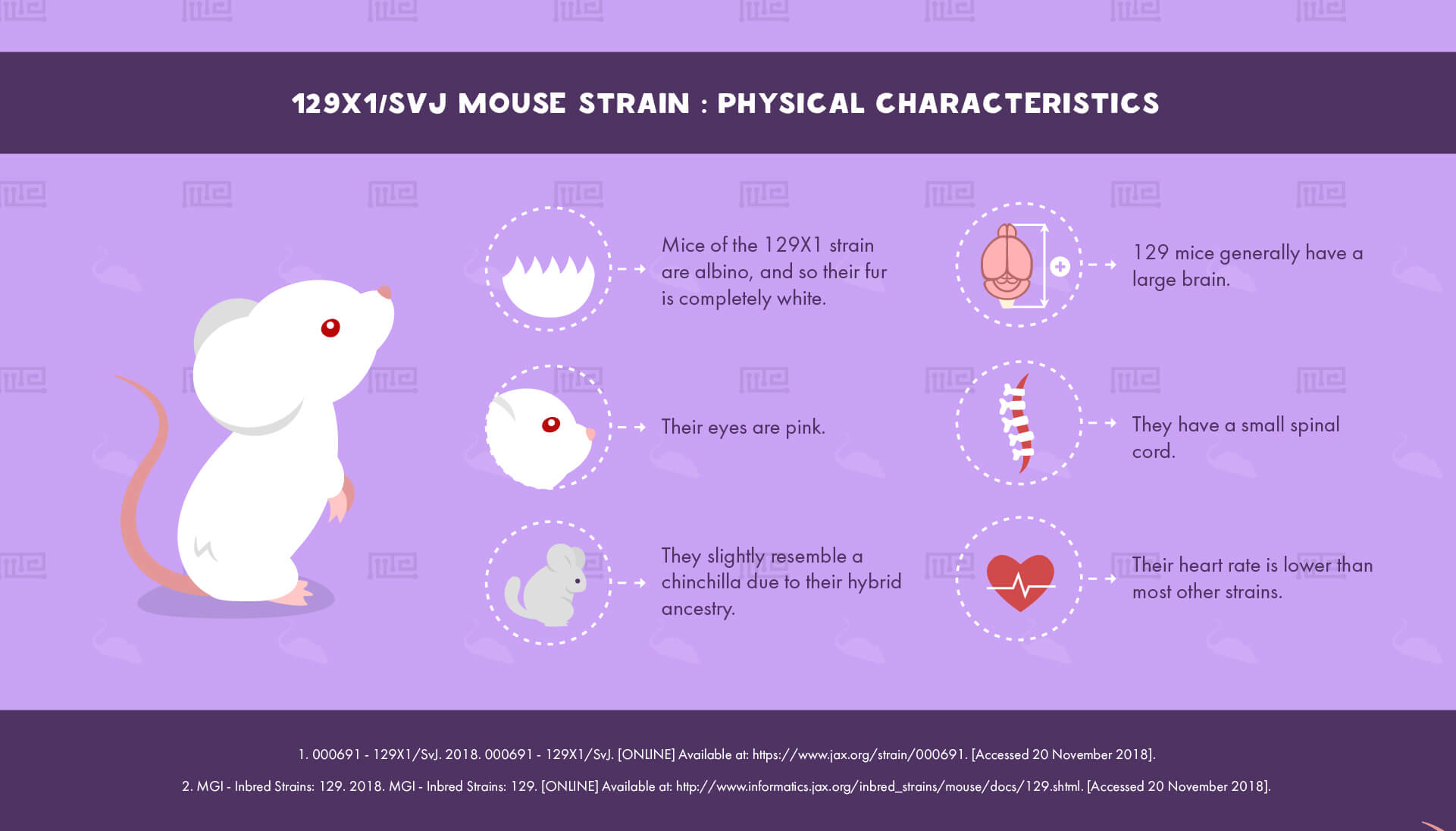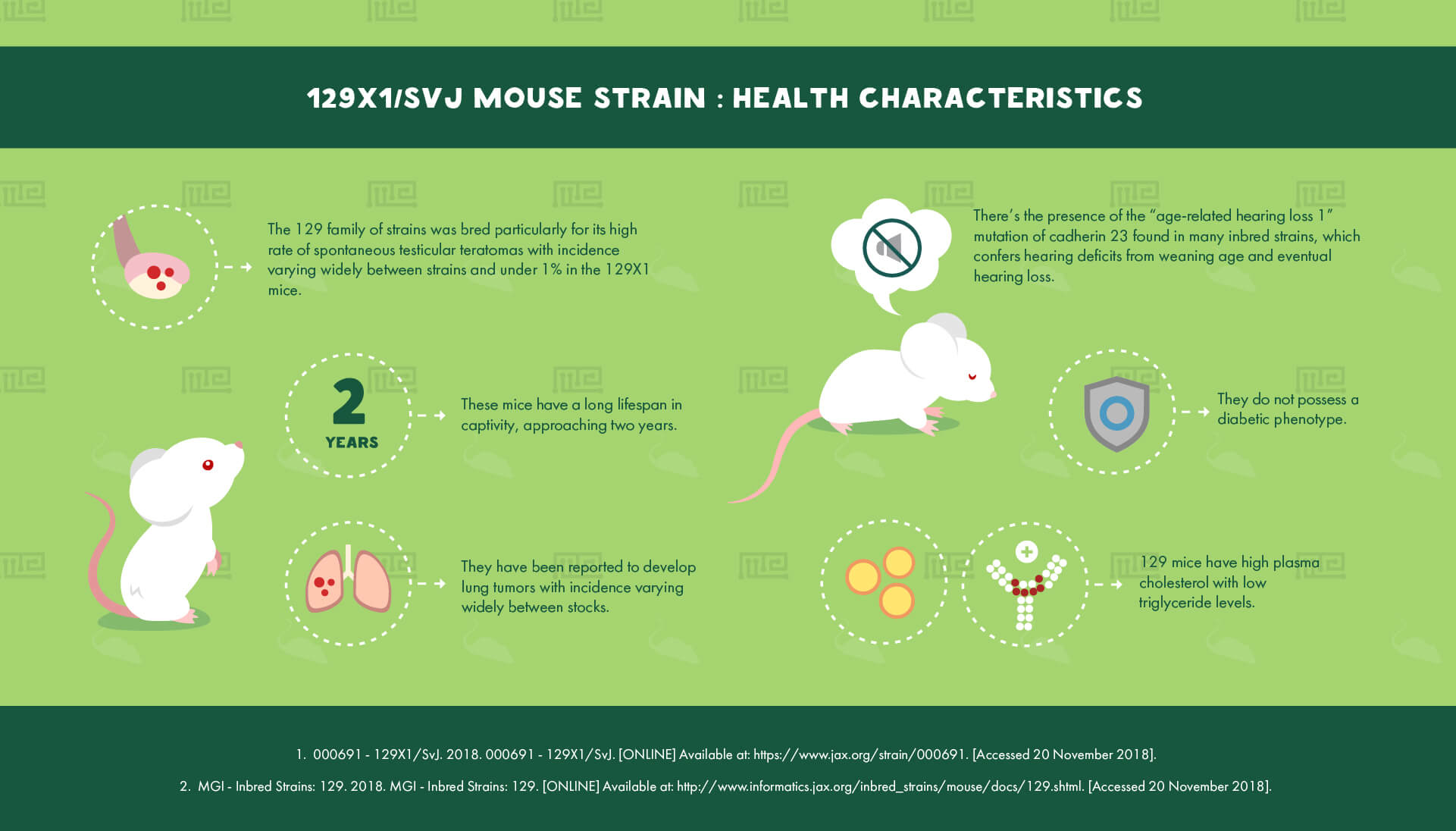Overview
129X1/SvJ, also known simply as 129X1, is an inbred strain of mouse that is popular for use in mutagenesis research.[1]
History
129X1 is part of the 129 family of strains, the original of which was created by Dunn in 1928. Dunn crossed English fanciers with a stock of chinchilla.[2] The 129/Sv variant, created by Stevens, became contaminated by another strain in 1978 for unknown reasons. Simple sequence length polymorphism analysis shows evidence of genetic contamination, but it is not known which strain contributed this genetic material. 129/Sv, the progenitor of the current 129X1, came to the Jackson Laboratory in 1982.[1]
Physical Characteristics
Mice of the 129X1 strain are albino, and so their fur is completely white.[1] Their eyes are pink, and they bear a slight resemblance to a chinchilla due to their hybrid ancestry (see above). 129 mice, in general, have a large brain and a small spinal cord, as well as a lower heart rate than most other strains.[2]
Behavioral Characteristics & Handling
According to the Jackson Laboratory, these mice are “gentle”. It seems then that researchers can have confidence in the docility of this strain. However, Jackson also cautions that the mice are very “crawly” (they like to hang off the cover of the cage), can chew through filter hoods, and have a strange tendency to put wood chips under the water bottle resulting in excessive dampness in the enclosure.[3]
Their breeding performance is described as “poor”, and the Jackson Laboratory warns that their first two to three litters may either be stillborn or eaten by the parents.[3] 129 mice also perform badly at avoidance learning, showing poor performance in the shock avoidance test[4] and low overall avoidance conditionability.[5]
Their preference for sweet-tasting substances in the sucrose preference test is low,[6] a result which is often taken to be indicative of anhedonia and a depressive-like phenotype. This is corroborated by the observation that they seem to be much less willing than a number of other common strains (including C57BL/6J, BALB/cJ, and DBA/2J) to press a lever in order to receive food in an operant conditioning experiment[7] (although this could also reflect a deficit in learning capability).
Health Characteristics
These mice have a long lifespan in captivity, approaching two years.[2] The 129 family of strains was bred specifically for its high incidence of spontaneous testicular teratomas. Incidence varies widely between strains and is under 1% in the 129X1 mice.[3] Lung tumors are also reported, with incidence varying widely between stocks.[1]
While plasma cholesterol is high in 129 mice, triglyceride levels are low, and a diabetic phenotype is not seen.[2] It is possible to induce an immune-mediate nephritis in this strain, associated with proteinuria (protein in the urine), glomerulonephritis (inflammation of the glomeruli in the kidneys) and tubulointerstitial disease (damage to parts of the kidney other than the glomeruli).[1]
Finally, 129X1 mice also carry the mutation “age-related hearing loss 1” of cadherin 23 found in many inbred strains, conferring hearing deficits from weaning age and eventual hearing loss.[1]
Major Experimental Uses
The 129X1 strain is of primary interest to cancer researchers, especially in the study of testicular cancer. These mice are also very useful for the creation of mutants and transgenics, as there are several embryonic stem cell lines derived from them.[1]
References
- 000691 – 129X1/SvJ. 2018. 000691 – 129X1/SvJ. [ONLINE] Available at: https://www.jax.org/strain/000691. [Accessed 20 November 2018].
- MGI – Inbred Strains: 129. 2018. MGI – Inbred Strains: 129. [ONLINE] Available at: http://www.informatics.jax.org/inbred_strains/mouse/docs/129.shtml. [Accessed 20 November 2018].
- The Jackson Laboratory Handbook on Genetically Standardized Mice. 6th ed. 2009. [ONLINE]. Available at: http://jackson.jax.org/rs/444-BUH-304/images/JAX%20Handbook%20Genetically%20Standardized%20Mice.pdf.
- Royce J. R., Yeudall L. T., and Poley W. 1971. Diallel analysis of avoidance conditioning in inbred strains of mice. J. Comp. Physiol. Psychol. 76, 353-358.
- Royce J. R. 1972. Avoidance conditioning in nine strains of inbred mice using optimal stimulus parameters. Behav. Genet. 2, 107-110.
- Lush I.M. 1988. The genetics of tasting in mice. VI. Saccharin, acesulfame, dulcin and sucrose. Genet. Res. 53, 95-99.
- McKerchar, T. L., Zarcone, T. J., & Fowler, S. C. 2005. Differential acquisition of lever pressing in inbred and outbred mice: comparison of one-lever and two-lever procedures and correlation with differences in locomotor activity. Journal of the experimental analysis of behavior. 84(3), 339-56.


